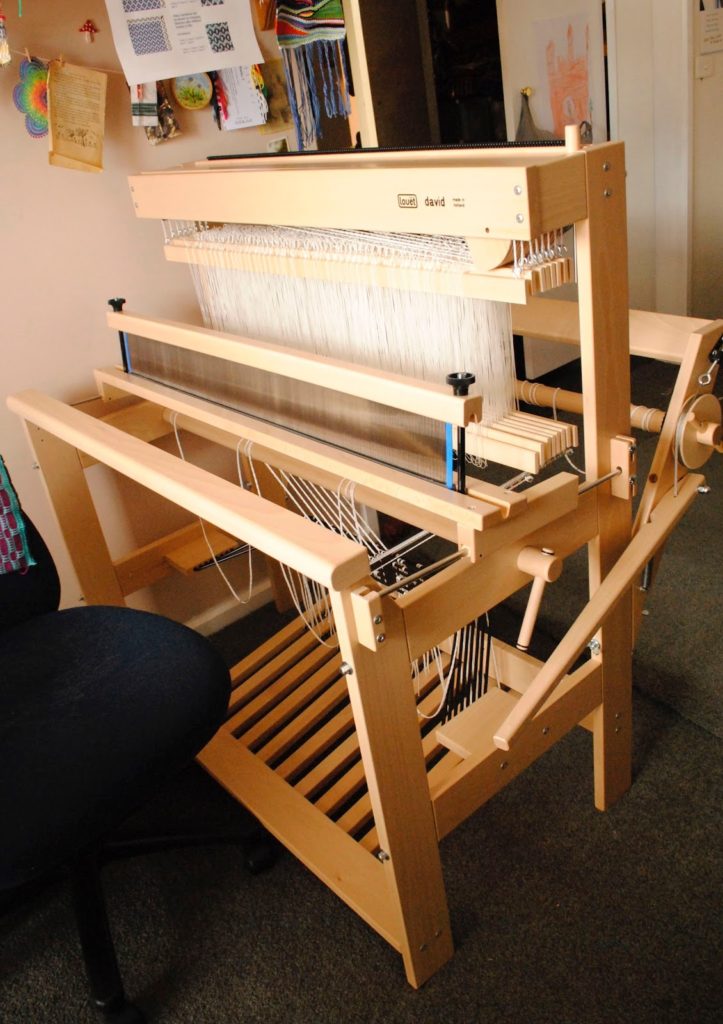It’s hard to know where to start the discussion on floor looms for a few reasons. There are many, many types of floor looms available from many different loom companies. Out of the three types of looms I have discussed in this series, a floor loom is the one that requires the most research on the part of the buyer to ensure the right loom is purchased.
My floor loom is the David 2 by Louet
There are 3 main types of floor loom available –
* Countermarch
*Counterbalance
*Jack
I’m not going to go into the specifics of each loom here, (my Introduction to Floor Loom Weaving course does that) but there are obvious differences between each one that should affect your decision making.
Lets have a look firstly at the benefits of a floor loom in general:
*Complex patterns can be achieved
*There are many choices for how many shafts, with many looms having upgrades to more shafts later.
*They are large and sturdy pieces of equipment
*They can take long warps and most looms have the ability to install a second warp beam for even longer warps.
*You can weave fast because your feet are operating the treadles, which in turn operate the shafts and there is no need to set the shuttle down in between picks.
*There are many resources available for floor loom weaving, in the form of books, online classes and face to face classes.
*Materials and parts and generally readily available.
*There are so many choices, from a basic 4 shaft to a computerised loom (depends on your budget!)
And, the negatives:
*Many floor looms are large and heavy, so not portable
*Depending on the loom, it can take up a lot of space – so you need to have room to house the loom as well as clearance space so that you can move around the loom for warping etc.
*A floor loom can be very expensive.
*The warping/threading process can be hard on your back.
*Warping is a long process, it takes a while to get used to this fact!
Would I recommend buying a secondhand floor loom?
Yes and no! If you already have a working knowledge of floor looms so that you can make an educated decision, then absolutely look for a secondhand loom, which can literally save you thousands of dollars.
BUT…
If you are completely new to floor loom weaving, have never used one and are not familiar with the parts and what they do, I would be very cautious about buying secondhand. Many people sell looms from a deceased estate or similar and they really know nothing about weaving or looms – even whether it is in working order. This can actually work in your favour if you are educated because the vendor may sell cheaply, not understanding the value of what they are selling!
When looking at a second hand loom ask yourself –
*Does it have all the necessary parts? If not, what is the make of the loom? Are these still made? Am I going to be able to get replacement parts? If the loom is in pieces – when was it last put together? Am I able to put it together? If the reed is rusty, am I confident that I can return it to it’s former glory? Am I going to regret this purchase because I have not researched enough? And, so on!
A great way to buy second hand can be through a weaving guild. The loom will generally have been well cared for and in use. The seller may be willing to give you a lesson on setting up. You can try it out before you buy in many cases. They will know the history of the loom.
Try not to be impatient, wait for the right loom at the right price.
The best advice I can give to someone who is in the market for a new or used loom is DO YOUR RESEARCH! Talk to people, read articles, get advice.
I hope this series has helped you to understand more about different types of looms.
For more on floor loom weaving, check out my free Youtube videos:
Or have a look at my Introduction to Floor Loom Weaving Course.
Until next time, Happy Weaving!
